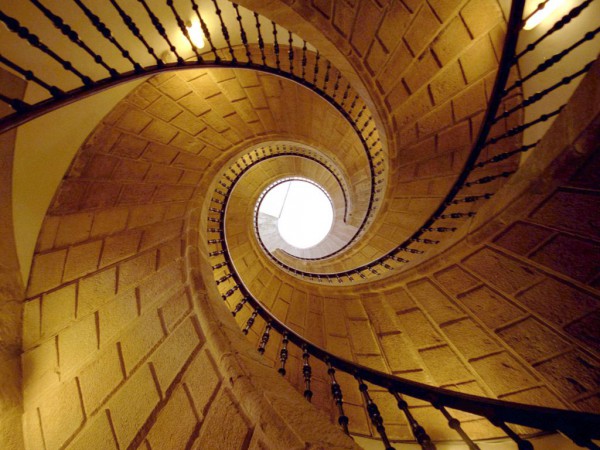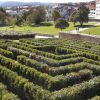Santiago’s secret spots
Whenever we go on a trip, we prepare a list of things that we don’t want to miss, places that the tourist guide indicates as musts. However, the more curious want something more, places that only city residents know about. Those spots and curiosities that make a city more mysterious and magical. We’ll tell you about a few of them.
Acoustic bench
Located in Alameda Park, just behind the bandstand, we come across this long semi-circular stone bench that carries the slightest sound along its entire surface. A traditional 19th-century garden bench, where couples without touching each other could share their affectionate secrets during Franco’s time. At that time, seeing an unmarried couple walking along the street without anyone accompanying them was frowned on. Therefore, this bench is said to have been a meeting place for many couples that, breaking the established rules in order to speak with their lover, came without their chaperones and sat at opposite ends of the bench. They could therefore speak by means of the acoustic bench, without anyone listening to their conversation and without raising suspicions by being too close.
The pilgrim’s shadow
The pilgrim’s shadow appears every night in Plaza de la Quintana. When night falls and the square’s lights are turned on, it can be seen at the base of the Clock Tower, beside the Holy Door. Many see in it the image of a pilgrim wearing medieval attire, with a hat and staff. However, it is made by the effect of the cathedral’s night lighting on a granite pillar.
There are many legends surrounding this shadow, but the best known is undoubtedly the love story between a priest and a nun in the Convent of San Paio. They used to meet every night in a secret passageway underneath the Quintana steps that linked the Cathedral and the convent.
After a while, the priest asked the run to run away with him, so that they would no longer have to hide their love. They arranged to meet at nightfall; the priest dressed up as a pilgrim so as not to catch people’s attention, but she, for some unknown reason, never turned up. Even so, night after night, the priest in love (or his shadow) still turns up to meet her. And he is still waiting for her.

The lost street
Many years ago, there was a street between “Rúa do Vilar” and “Rúa Nova” known as “Rúa de la Balconada”. It has now been blocked off, without any entrance, and turned into gardens accessed from the aforementioned streets.
The street was closed after the murder of an archbishop. According to legend, a captain with a beautiful daughter who was desired by many nobles, when he had to go off to war, left her in the care of a knight so that nobody could court her. The bishop of Compostela, Suero Gómez, who was in love with the young woman, took advantage of the said knight’s absence to abduct her. When the captain heard what had happened, he returned to Santiago on the feast of Corpus Christi and, during the traditional procession along the mythical Rúa da Balconoda towards Rúa Nova, found the bishop and killed him.
Diego de Muros cited the following traditional song:
“Goodbye, beautiful Rúa Nova,
Calle de la Balconada,
they killed an Arcbishop
and it was because of a madam!”
This street can only be seen from above, for example, from the rooftops of Santiago Cathedral.

The Belvís labyrinth
In Belvís Park there are three identical labyrinths occupying an area of 4,000 square metres. Peculiarly, they are made of camellia hedges, which reach a height of 1.8 metres, enough for those who enter to get lost. Experience the sensation of being surrounded by vegetation, with the sky as a roof, and enjoy the itinerary without worrying about finding the exit. The Belvís labyrinth is the only one of its kind in Europe.

History Faculty Library
The University of Santiago de Compostela’s Geography and History Faculty is located in Plaza de la Universidad, in the city’s old town. Its main jewel is its extraordinary library, which was established in 1924 to support the university. Inspired by the old monastery reading rooms, it has thousands of priceless volumes and features wooden furniture and lamps from that time.
The library is open to everyone, whether they are students or not, as a reading and study room. If you want to visit it, you just have to enter the faculty and find it. Libraries are undoubtedly the favourite places of book worms, but some of them, like the one mentioned above, are also artistic gems that are worth visiting.

The Galician poetess Rosalía de Castro’s tomb
In 1891 several Galician associations abroad decided, as an act of Galician nationalism, and with the consent of the Rosalía de Castro’s family, to move her remains from the cemetery of Adina de Iria Flavia to the Church of San Domingos de Bonaval in Santiago de Compostela, thereby paying tribute to the Galician poet and writer.
Rosalía de Caustro was buried in the mausoleum, which was made specifically for her, located in the Pantheon of Illustrious Galicians. This place also houses the remains of other important Galician figures such as, for example, Castelao. Rosalía was the first one brought here.
You can only access the Pantheon of Illustrious Galicians from the Museo do Pobo Galego (ethnographic museum).






